In this article, I will be discussing how to get the best from your Bonsai. Bonsai trees are fascinating plant that brings the beauty of the Japanese art to your home, being either inside or outside.
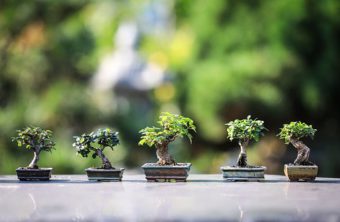
To some or should I say the many bonsai trees are the most beautiful plant you can have, even more, pleasing than orchids, and that is saying something. When you see bonsai tree displayed in flower shows, your breath is often taken away, especially when you discover that the plants are often older than the show itself.
They display the perfection of a maturity in a miniature form with their windswept branches and gnarl-looking trunk of a mountain tree. All this and often the tree is less than 50cm in height.
BONSAI ARE DIVIDED INTO TWO CATEGORIES

Firstly you must release that bonsai are divided into two categories that are more suitable for growing indoors and those who need to be placed in a patio or balcony to be at their best. Indoor bonsai have been bred to be specific to remain indoors at all time without killing the bonsai. Saying that it will not harm a bonsai to place indoor types outside in summer as you would do a lemon tree here in the UK.
You often see bonsai tree growing in containers or should I say dishes that barely hold enough compost to maintain the plant for months let alone years, but yet it survives. The bonsai is proof that plants with proper care in potting, feeding and pruning it is possible to have a plant survive hundreds of years.
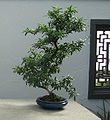
Saying all that it is still a challenge for bonsai tree grower as it not only demands patience but you must have an artist eye, to keep the tree in the right proportions and also be stylish. Get it right and the results will be very rewarding.
TYPES OF TREES THAT CAN BE USED
The type of tree that can be used is so dependent if you want an indoor or outdoor bonsai. There is a wide range of trees that cover both outdoors and indoors.
OUTDOOR BONSAI

One of the most attractive and most suitable for the beginner is the Acer palmatum (Japanese Maple) that have beautifully coloured bronze and red foliage in autumn.
Cotoneaster and Pyracantha (Firethorn) are also colourful shrubs that can be used. Both bearing flowers that are followed by scarlet or orange berries. The firethorn will need to be pruned vigorously to keep it small but will reward you with a stunning display.

Pinus parviflora (White Pine) and Juniper often look like a traditional bonsai tree specimen. These are perfect subjects to use as both are naturally small trees. The juniper in particularly is suitable as it can grow erect and upright as possible or it can cascade downward where the branches hang over the sides of the pot like a tree growing at the side of the cliff.

Crataegus cayathe (Hawthorn) is the plant to use if you want to plant in groups, as on its own it will look thin and bare, You will either plant in groups of 3 or 5 or any other odd number combinations. In this display, the largest specimen is planted up front to give the more striking effect.
If the gnarled trunk is your thing, then you can use Carpinus betulus (Hornbeam) or Malus (Crab Apple), as these make an excellent choice. The latter has the added bonus of producing blossoms in spring.

Many traditionally British trees can be used to good effect, such as beech and ash that can be trained to give interesting shapes. This is particularly true if the creeping varieties of these trees are used.
INDOOR BONSAI

The indoor type bonsai can be permanently housed indoors include:
Ulmus parvifolia (Chinese Elm) is a natural-looking plant that is perfectly proportioned. It is not a fussy plant and is perfect for beginners with its twisted, twiggy structure. It grows fast and so is ideal for beginners to learn how to prune and develop styling techniques.
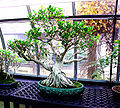
If you a looking for a bonsai that looks oriental, produces flowers and have glossy, green leaves then Carmona microphylla (Oriental Tee Tree) is for you. A neutrally slow-growing bonsai that requires little pruning or maintenance, this bonsai likes to be placed in warm homes.
For rooms that are in the shade or for those who want a tree with dark green, glossy leaves then Ficus retusa (Fig tree) is recommended for you. It has a wonderfully textured bark and is ideal for those who want a bonsai that is easy to look after.
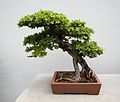
If you want a bonsai that fruits or has some variation in leaf colour then Sageretia theezans (Chinese Sweet Plum) is for you. This easy to grow bonsai has small purple fruits as it matures, whilst the young, new leaves have some red. An easy to grow plant that is not fussy to what position it is grown in.
Another flowering bonsai is Serissa foetida (Tree of a Thousand Stars) which has small, elongated green leaves that are smooth around the edges. The bark is elegantly beige brown and is flaky in texture. In mid to late summer small, white star-shaped flowers are produced that add beauty to this tree.
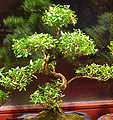
Zanthoxylum piperitum (Aromatic Pepper Tree) is an unusual indoor bonsai that it has aromatic bright green, feathery leaves that are peppery fragrant. It is easy to care for and from January onwards, minute white flowers are produced. This is a bonsai that hunters who are looking something a little different to buy. The bark is often fissured and add character and age to the bonsai.
Ligustrum sinense (Olive Family) is actually a relative of the olive tree. It is very fast growing making it ideal to be pruned and styled. This bonsai is the recommended variety for absolute beginners as it is not fussy to what position it is placed or grown in. The bright green leaves are beautifully proportional to the tree and have smooth edges. The trunk is strong and vigorous and as an added bonus it produces pretty white flowers. A beautiful and elegant bonsai.

Loropetalum chinensis (Chinese Blush Tree) is a member of the witch hazel family that has lush, purple leaves and bright pink, spidery flowers. Of all the indoor bonsai this is one of the most colourful and it is easy to care for, where it will make an ideal specimen for beginners.
Portulacaria afra (Jade Tree) is a bonsai that requires less watering than the other, so it offers a distinct advantage. An ideal bonsai for children to look after. It has small, fleshy leaves and a compact growing habit, It will even survive growing in warm temperature, which is unusual for bonsais. It is similar to Crassula in appearance but the leaves are rounded and it grows less big. An easy to care for plant that is great for child and adult to look after.
The bonsai will fill a need either on the balcony and patio or in the home. The decision is left up to you.
POSITIONING

Bonsai are natural houseplant and if you deprive an outside bonsai of good air ventilation then it will reward you by shedding all it leaves and dying. Although modern bonsai growers have developed trees that can live permanently in the home, whilst all other bonsais is essential that they are not kept outdoors for the majority of the time.
This is because they are still small trees that prefer to be grown outdoors. A sheltered balcony or patio makes an ideal location, or they can be protected above and the side by a special design bonsai house.

When outdoor varieties are brought indoors they should be given as much natural light as possible and kept away from draughts and excessive heat. Non-indoor type of bonsais should not be indoors for more than 6 days and care must be taken when removing a bonsai from a warm room directly to cold, winter air outside.
You will need to acclimatize the plant by placing it in a cold room first and then move it outside once it has got used to the cold temperatures. If very cold weather is forecast then you can protect the roots by covering with compost or straw.
WATERING
Outdoor bonsais will survive on the rainfall it receives during its time outdoors. Inside bonsais or outdoor bonsais when inside will need to be watered regularly at all times, as it is essential that the compost is moist.
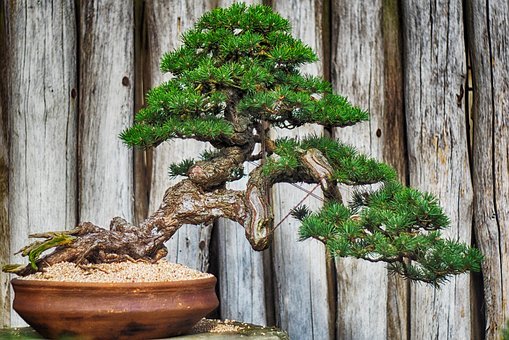
In hot weather, it may be required to water twice a day, and the plant must not be neglected (apart from the Jade tree that can take less watering); Water deprivation can cause a tree to die. Rainwater is best for bonsais, no matter if it is an indoor or outdoor, or if this is not possible you can use tap water if it is allowed to stand overnight.
Bonsais are heavy feeders and it is best to feed weekly or once every two weeks with a specialised bonsai liquid fertiliser.
They will also benefit from regular misting to keep them at tip-top shape.
PROPAGATION
Most indoor and outdoor bonsai can be bought from refutable garden centres or if you want to start from scratch you need to hunt for outdoor bonsai specimens.
For outdoor specimens look for deciduous plants or shrubs with small leaves. Hawthorn or hornbeams plants being sold for hedging are the best, as these will be smaller than ones sold as a feature plant for the garden.
Crab apple bonsai must be grown from seed as those generally sold are mature trees and obviously too big to move inside and outside.
If you want to do this sow seeds in autumn or you can take cuttings from an existing crab apple tree. If you can find one you need to cut 20cm long branches from this year’s growth in October.
Cotoneaster can also be grown from cuttings inserted into a sandy seed and cutting compost, or alternatively, you can buy small plants.
THERE IS A CHEAP WAY TO ACQUIRE PLANTS
A cheap way to acquire plants is to take young seedlings of 2 to 3 years old growing under the parent tree. The ideal time to take the seedlings will be early spring.
Choose a well-developed seedling, whilst pruning out any spindly branches. If the seedling has a small mass of fibrous root near the trunk then it can be safely planted in a container.
If the roots are too long, prune back to within 15cm of the trunk and plant out in the garden for a whole year, before using them as a bonsai specimen.
When you are potting your plant, make sure that the container you choose will complement the plant. It must have drainage holes to remove any excess moisture.
The tree that is chosen needs to grow in a media of loam soil, leaf mould or peat or any other organic matter, and sharp sand in equal proportions. The tree will need to be watered afterwards to help it establish quickly.
MAINTENANCE
It is essential that a bonsai tree is pruned to maintain its health and to keep its form. Firethorn and white pine especially need to be pruned, otherwise, they tend to get congested. All indoor and outdoor bonsais will benefit from being pruned.
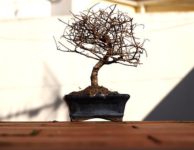
During winter and early spring cut away dead branches, crossing branches and any misplaced branches close to the trunk.
Any evergreen tree-like juniper that have needle-like leaves should have growth pinched out. Fruiting trees should not be pruned until July except for their growing tips.
To achieve a strong, healthy tree with a good, strong trunk with firm branches and good form, you will need to shorten all growth to the first or second leaf or sets of leaves. Careful pruning to a suitably positioned bud can usually achieve branches following a desired direction.
KEEP THE TREE IN SHAPE
You must remember with all bonsai subject the shape of the tree is important, even if it has been defoliated, it must look attractive.
If you want a curved or twisted trunk them a branching wire must be used. This should be done in the early years of the tree’s development in June or July when the plant is at its most supple. Choose a wire that is slightly less pliable than the branches or trunk, and then anchor to the soil or around the trunk itself. You will need to wind it loosely around the branch or trunk then gently bend it down to the desired position. You need to ensure that the wire remains in position for at least six months or a year before being removed.
Bonsais will need to repotted in early spring every year or two for plants under ten years in age, and between two and ten years for more mature trees. On the whole, evergreens need repotting less often than deciduous tree.
What you need to do is gentle free roots from the soil by teasing the outer roots until they move freely. The free roots need to be pruned back to one-third of their original length and this includes the strong taproots. The containers need to be washed out, cleaned and then fresh compost of the composition mentioned before being placed in the same pot.
If the tree is in danger of toppling over you may need to thread the wire through the drainage hole and secure around the lower part of the tree for extra stability.
In order to minimise shock and prevent killing the plant do not prune the branches and repot at the same time.
CONCLUSIONS
In this article, we have discussed how to get the best from your bonsai. As you can see it is not too difficult to grow bonsai as long as you get the selection right.
The first thing that must be considered is if you want an indoor or outdoor bonsai. If you want an outdoor bonsai then you can buy trees and shrubs of the recommended varieties and then plant them in the container of the right size. As the tree grows you can then prune and shape to your heart content.
You can also use cutting or seedling growing under the tree to start your own outdoor bonsai display. A wide range of shrubs and trees can be used to do this, which can be bought online or from garden centres.
For indoor bonsai, you need to find specimens that have been carefully shaped for you and then you will need to maintain them throughout the plants’ life. As you see here are a number of indoor specimens that can be used, some of them easy to maintain that a child can do it.
I hope you can now see that bonsai are useful as a houseplant or you can have it as part of your patio or balcony display. It is not too difficult to have a bonsai in your home, as long as you are prepared to prune, rehouse, water and feed them regularly.
If you have any bonsai related comments or questions that you wish to make, please do so in the comment box below.
Have you thought about starting a bonsai display yet?
Thanks.

I have to agree that Bonsai trees are fascinating plants and a great tribute to Japanese art. I can remember watching The Karate Kid many years ago and thinking that I would like to have a Bonsai tree of my own. I can remember vaguely having one, so this is an excellent reminder about the tree and I’m glad to have come across your post here. To be honest I had no idea that Bonsai trees are separated into two categories and it’s important to know that there are outdoor and indoor species. I think I’ll start up again with an indoor plant. The Sageretia Bonsai looks great to me. I appreciate the maintenance information as I know that the Bonsai tree takes a little more maintenance than with other plants. I’m looking forward to checking out your links and reading more. Thanks for the excellent information and recommendations on Bonzais!
Hi Pentrental
Thank you for this insightful comment about bonsai and I do remember the Karate Kid and the scene you mention does make you want to get a bonsai tree. It is such an art and science to growing one. If you do not get the watering, feeding, repotting and pruning right, you could have wasted a lot of time and effort. My article was written with this in mind.
Kind regards
Antonio
My husband wants me to learn patience with a bonsai tree, so I am trying to figure out how to grow one perfectly. I am very glad that you made us another complete article on a bonsai tree, there are some aspects that I did not think about myself, like do I need an indoor or an outdoor bonsai tree.
Now after reading your post and checking which one I find beautiful, I chose the Ulmus parvifolia (Chinese Elm). An indoor bonsai, I love the colors, it is a very beautiful tree. Now, where can I get it?
THanks
Hi Adyns
Bonsais will most certainly teach you how to be patient. I have covered all aspects that you need to have a happy and healthy specimen. Bonsais can generally be bought from bonsai tree specialists and they are great houseplants. I hope your husband gets you one.
Thanks
Antonio
I love plants but unfortunately, I don’t manage to keep my potplants alive for very long. I have heard that Bonsai Trees are extremely hard work and if you don’t know how to look after them properly, they die very easily. This has been the only reason that I haven’t gotten one of my own, as they are expensive and I would hate to have it die on me. Your instructions do make it look easier to care for them than I imagined it would be.
Hi Michel
They do have a reputation of being difficult to look after but like orchids if you fo it right, you will be rewarded multiple times. It is all about getting the watering and feeding right, otherwise you would have lost an expensive plant.
It is not as difficult as people make it out to be.
Kind regards
Antonio
Could I congratulate you on a very well written, in-depth review of bonsai trees! The knowledge this review contains is amazing. I’ve alway wanted to own my own bonsai tree but always thought it was too expensive but it’s not. You clearly put me right on that thought but I didn’t realise there was so many to choose from. The weather in the UK can be very up and down, so it’s going to be a indoor one for me. But which one?
Hi Derek
The answer to your question is dependent on how much money, time and effort you are prepare to invest. They are all beautiful and can grace any home, so why don’t you get one today.
Thanks
Antonio
Well done for your information on Bonsai trees. I, like so many others have found that since “The Karate Kid” and looking for that perfect Bonsai both for myself and as gifts for others, it has always been very difficult to look after them. However, the information that I can see from here has somewhat changed my mind especially at a time when I am looking to pay more attention to my garden outdoors.
I am not too sure of a display of Bonsai could be a step too far though.
When you mention repotting of the Bonsai tree is this due to the fact of space or for another reason?
What is the best utensil to use for pruning for both roots and branches?
Hi imelda
Thank you for stopping by and commenting. I think Bonsais make excellent gifts for Christmas and Birthdays, as long as the recipient is made aware of how to care for them. As often failure is resulted by not following instructions.
Repotting is required for two reasons to introduce new growing media and to help the roots to grow into. This will fertilize the tree and prevent it from getting root bound.
Pruning is better with fine scissors or secateurs, after all they are small trees.
Kind regards
Antonio
hello thanks for such an interesting article about bonsai tree. Many people think that training Bonsai trees is a bad pastime because the cultivator starves the tree and cuts it to such an extent that it becomes unhealthy.Yet the reverse is usually true; while they are cut and pruned heavily to maintain them to the size of the pot, they are usually transferred from pot to pot regularly and are fed and watered much more often than their wild cousins. For long i have looking for a trust worthy garden expert to till today i found one. thanks.
Hi Mugalu
Thank you for those kind words. I try to be as helpful as possible and try to give as much relevant information as possible. You are right bonsai are greatly misunderstood they do need regularly pruning feeding watering and repotting. The plants tend to be better looked after than those growing outside and that is the reason they thrive indoors and outdoors.
Kind regards
Antonio
Bonsai plants are really beautiful. I have one in my garden. Really gives off a feeling of calmness and relaxation. It’s really, dare I say, weird for a plant that small to have such an effect on myself. Perhaps it’s just the way it looks, or it might have magical properties!
Kidding aside, really great post! Thanks for sharing!
Hi OCG
I think bonsai are one of the most beautiful houseplants that you can buy, no matter if you are using them inside or out. I think bonsai should be grown in any home as it teaches you a lot, especially patience.
Thanks
Antonio